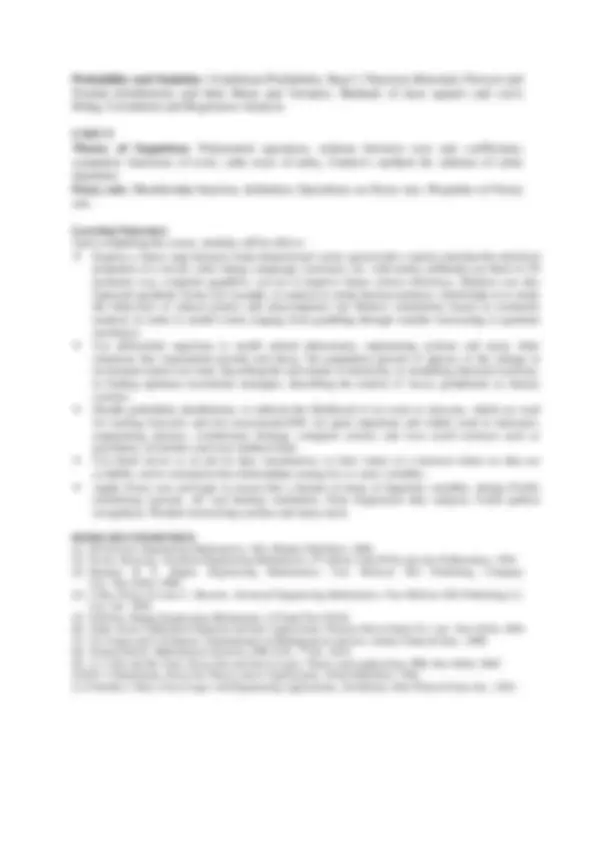



Study with the several resources on Docsity

Earn points by helping other students or get them with a premium plan


Prepare for your exams
Study with the several resources on Docsity

Earn points to download
Earn points by helping other students or get them with a premium plan
Community
Ask the community for help and clear up your study doubts
Discover the best universities in your country according to Docsity users
Free resources
Download our free guides on studying techniques, anxiety management strategies, and thesis advice from Docsity tutors
physics engineering notes for computer science engineeering davv
Typology: Lecture notes
1 / 2

This page cannot be seen from the preview
Don't miss anything!


Devi Ahilya University, Indore, India Institute of Engineering & Technology BE I Year (Common to all branches) Semester- 2 Subject Code & Name Instructions Hours per Week Credits AMR2C1: Applied Mathematics-II L T P L T P Total 3 1 - 3 1 - 4 Duration of Theory Paper: 3 Hours Learning Objectives: To introduce the mathematical concepts of Matrix Algebra, Differential Equation Probability and Statistics and Fuzzy sets for solving engineering problems that shall be used in various branches of engineering. Provide the basics of Matrix mathematics useful in providing a more compact way to deal with groups of equations in linear algebra; Differential equations, a mathematical equation that relates some function (usually represent physical quantities) with its derivatives (represent their rates of change), and the equation defines a relationship between the two; Probability distributions describe the dispersion of the values of a random variable;Curve fitting and regression analysis, to find the "best fit" line or curve for a series of data points; Theory of equations, which tells when an algebraic equation has an algebraic solution; Fuzzy sets generalize classical sets (Crisp sets), as the characteristic functions of classical sets are special cases of the membership functions of fuzzy sets. Prerequisites: Knowledge of basics of determinants, matrices, derivatives, integrals, sets, probability and statistics. COURSE OF CONTENTS UNIT-I Matrix Algebra:Review of Matrices; Elementary Operations on Rows and Columns; Normal Form; Linear Dependence; Rank; Application of Rank Theory in Solving System of Linear Equations; Linear Transformation; Orthogonal, Unitary and Hermitian Matrices; Characteristic Equation; Eigen- Values and Eigen-Vectors; Caley-Hamilton Theorem; Quadratic and Linear forms. UNIT-II First Order Ordinary Differential Equation: Exact Differential Equation; Equations Solvable for x, y and p; Clairaut’s Form; Application to Simple Problems. Higher Order Ordinary Differential Equation: Linear Differential Equations with Constant & Variable Coefficients; Method of Variation of Parameters, Simultaneous Differential Equations; Application to Simple Problems. UNIT-III First Order Partial Differential Equations: Formation of Partial Differential Equations; Partial Differential Equations of First Order and First Degree i.e. Pp + Qq = R. Higher Order Partial Differential Equations: Linear Homogenous Partial Differential equations of n th order with constant coefficients; method of Separation of variables; their Simple applications. UNIT-IV
Probability and Statistics : Conditional Probability, Baye’s Theorem; Binomial, Poisson and Normal distributions and their Mean and Variance, Methods of least squares and curve fitting, Correlation and Regression Analysis. UNIT-V Theory of Equations: Polynomial equations, relation between root and coefficients, symmetric functions of roots, cube roots of unity, Cardon’s method for solution of cubic equations. Fuzzy sets: Membership function, definition, Operations on Fuzzy sets, Properties of Fuzzy sets. Learning Outcomes: Upon completing the course, students will be able to: Express a linear map between finite-dimensional vector spaceswith a matrix,calculate the electrical properties of a circuit, with voltage, amperage, resistance, etc. with matrix arithmetic,use them in 3D geometry (e.g. computer graphics), can try to improve linear solvers efficiency. Matrices can also represent quadratic forms (for example, in analysis to study hessian matrices, which help us to study the behaviour of critical points) and alsocomputers run Markov simulations based on stochastic matrices in order to model events ranging from gambling through weather forecasting to quantum mechanics. Use differential equations to model natural phenomena, engineering systems and many other situations like exponential growth and decay, the population growth of species or the change in investment return over time, describing the movement of electricity, in modelling chemical reactions, in finding optimum investment strategies, describing the motion of waves, pendulums or chaotic systems. Handle probability distributions, to indicate the likelihood of an event or outcome, which are used for making forecasts and risk assessments.Pdf's are quite important and widely used in insurance, engineering, physics, evolutionary biology, computer science and even social sciences such as psychiatry, economics and even medical trials. Use fitted curves as an aid for data visualization, to infer values of a function where no data are available, and to summarize the relationships among two or more variables. Apply Fuzzy sets and logic to reason like a human in terms of linguistic variables, design Traffic monitoring systems, AC and heating ventilation, Gene Expression data analysis, Facial pattern recognition, Weather forecasting systems and many more. BOOKS RECOMMENDED: [1] B.S.Grewal, Engineering Mathematics, 39/e, Khanna Publishers, 2006. [2] Erwin. Kreyszig, Advanced Engineering Mathematics, 8th^ edition, John Willy and sons Publications, 1999. [3] Ramana B V, Higher Engineering Mathematics, Tata McGraw Hill Publishing Company Ltd., New Delhi, 2006. [4] C.Ray Wylie & Louis C. Barretle, Advanced Engineering Mathematics, Tata McGraw Hill Publishing Co. Ltd., 6/e, 2003. [5] H.K.Das, Higher Engineering Mathematics, S.Chand New Delhi. [6] Zafar Ahsan, Differential Equation and their Applications, Prentice Hall of India Pvt. Ltd., New Delhi, 2004. [7] S.C.Gupta and V.K.Kapoor, Fundamentals of Mathematical statistics, Sultan Chand & Sons., 2000. [8] Freund John E, Mathematical Statistics, PHI, N.D., 7 th^ Ed., 2010. [9] G. J. Klir and Bo Yuan, Fuzzy Sets and Fuzzy Logic: Theory and Applications, PHI, New Delhi, 2005. [10] H. J. Zimmerman, Fuzzy Set Theory and its Applications, Allied Publishers, 1996. [11] Timothy J. Ross, Fuzzy Logic with Engineering Applications, 3rd Edition, John Wiley & Sons, Inc., 2010.